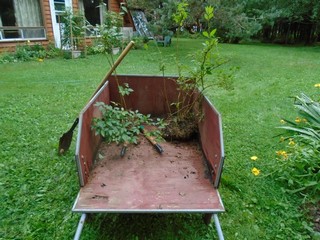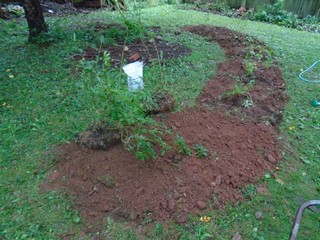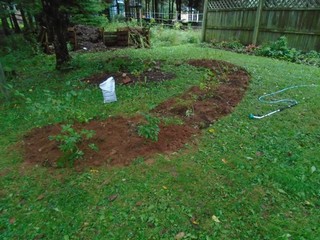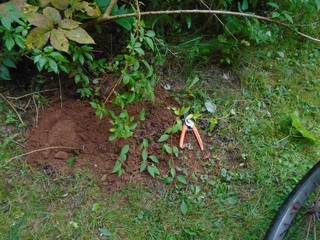Adding to the Existing Shrub Bed
Deciding that the existing bed was too small an extension is added and some more forsythia is added and the old bush is steadied in place

A trip back to the mother forsythia shrub secures a couple of transplants to use in the bed extension.

They are again placed a foot or so away from their individual planting spots. This gives a good idea of how they will look in place and adjustments are best made before they are placed in their respective holes. Plants are tough but it is best to treat them well.and kindly. Lessons for life.

The plants are in place and surrounded with a soil and peat mix as were the others. Bihind them is a bag of 5-10-10 fertilizer with slow release fertilizer and a scant half handful is in each hole. I put it in place and dig it into the bottom of the hole and cover it with a bit of soil before the plant goes in. Our soil is fairly clay dominant and a bit of boost to the root system seems to help.

While flooding in these plants I take the time to water in the others once again. I will water them every dy for a week. I am not sure if this is overkill but I find that it works well for me. If it works well, why stop?

Back at the mother bush I am filling the holes with the remainder of the soil/peat/compost mix left over from filling in the holes around the transplants. While doing so I noticed one (actually several) of the branches bending down to the earth. This is a natural way for forsythia to reproduce. To help it along I covered over part of the branch with soil having an expectation that I would like more offshoots in the future. My secaturs are on the soil at the place where I have done so.

by next spring this will likely be a good candidate for separation. I may not move it then but if a gentle tug indicates it has rooted I will likely cut it from the mother and dig around it with a shovel to stimulate the roots to grow as if in a pot.
